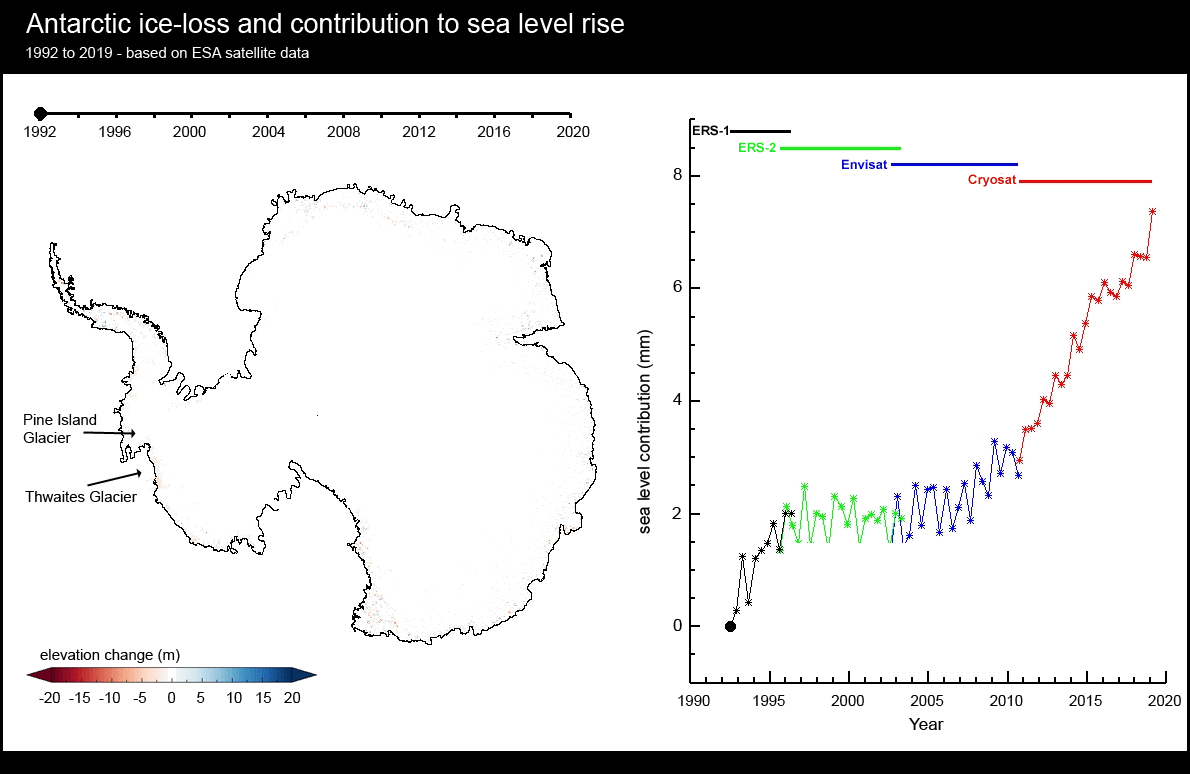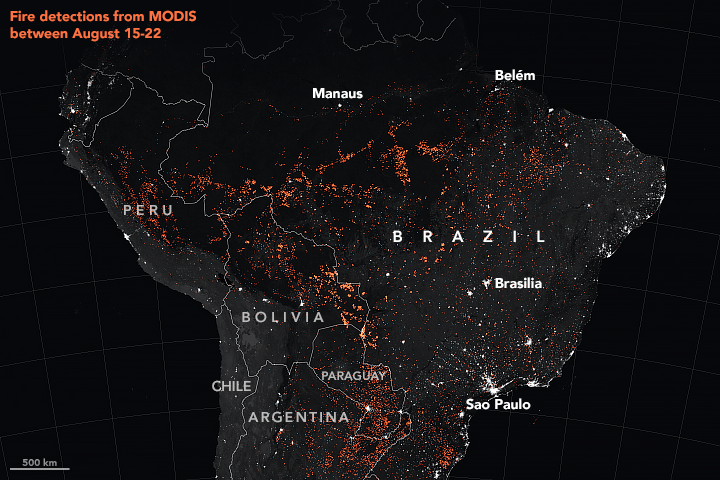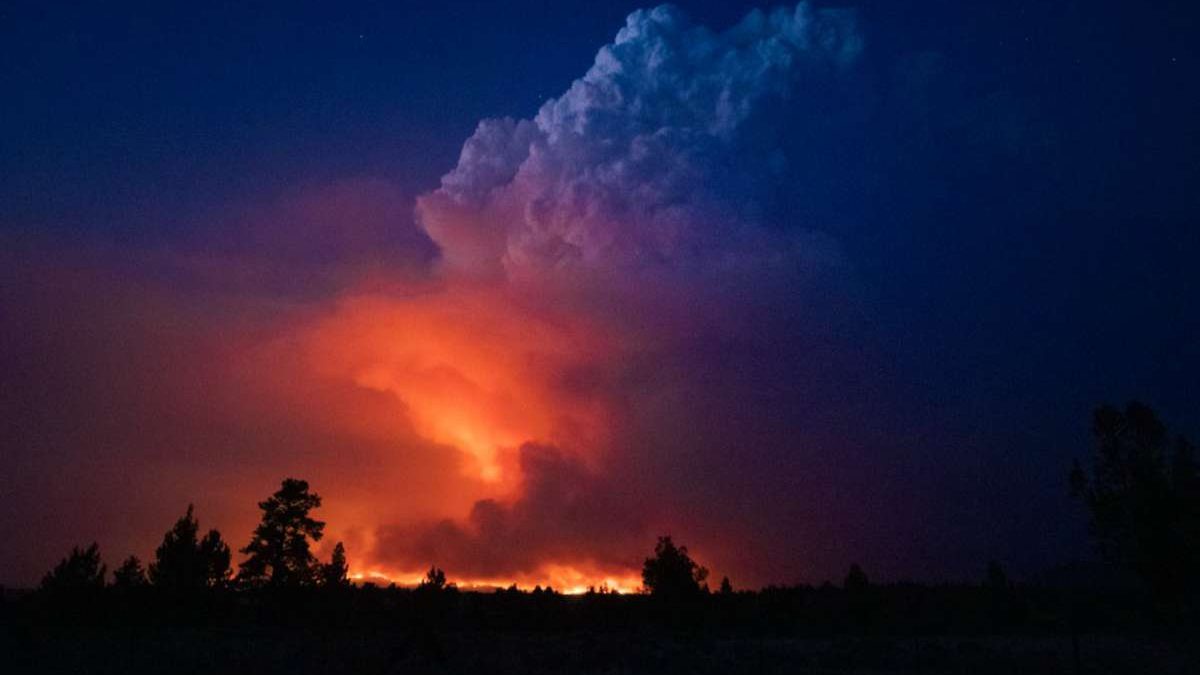A quarter of West Antarctic ice is now unstable – “A wave of thinning has spread rapidly across some of Antarctica’s most vulnerable glaciers, and their losses are driving up sea levels around the planet”
Time sequence of Antarctic glacier ice thickness change (left) and associated contribution to sea level rise (right) between 1992 and 2017. Graphic: Shepherd, et al., 2019 / Geophysical Research Letters
16 May 2019 (University of Leeds) – In only 25 years, ocean melting has caused ice thinning to spread across West Antarctica so rapidly that 24 percent of its glacier ice is now affected, according to a new study.
By combining 25 years of European Space Agency satellite altimeter measurements and a model of the regional climate, the UK Centre for Polar Observation and Modelling (CPOM) have tracked changes in snow and ice cover across the continent.
A team of researchers, led by Professor Andy Shepherd from School of Earth and Environment at the University of Leeds, found that Antarctica’s ice sheet has thinned by up to 122 metres in places, with the most rapid changes occurring in West Antarctica where ocean melting has triggered glacier imbalance.
This means that the affected glaciers are unstable as they are losing more mass through melting and iceberg calving than they are gaining through snowfall.
The team found that the pattern of glacier thinning has not been static.
Since 1992, the thinning has spread across 24 percent of West Antarctica and over the majority of its largest ice streams – the Pine Island and Thwaites Glaciers – which are now losing ice five times faster than they were at the start of the survey.
Using satellites to track Antarctic ice
The study, published today in Geophysical Research Letters, used over 800 million measurements of the Antarctic ice sheet height recorded by the ERS-1, ERS-2, Envisat, and CryoSat-2 satellite altimeter missions between 1992 and 2017 and simulations of snowfall over the same period produced by the RACMO regional climate model.
Together, these measurements allow changes in the ice sheet height to be separated into those due to weather patterns, such as less snowfall, and those due to longer term changes in climate, such as increasing ocean temperatures that eat away ice.
Lead author and CPOM Director Professor Andy Shepherd explained: “In parts of Antarctica the ice sheet has thinned by extraordinary amounts, and so we set out to show how much was due to changes in climate and how much was due to weather.”
To do this, the team compared the measured surface height change to the simulated changes in snowfall, and where the discrepancy was greater they attributed its origin to glacier imbalance.
They found that fluctuations in snowfall tend to drive small changes in height over large areas for a few years at a time, but the most pronounced changes in ice thickness are signals of glacier imbalance that have persisted for decades.
Professor Shepherd added: “Knowing how much snow has fallen has really helped us to detect the underlying change in glacier ice within the satellite record.
“We can see clearly now that a wave of thinning has spread rapidly across some of Antarctica’s most vulnerable glaciers, and their losses are driving up sea levels around the planet.
“Altogether, ice losses from East and West Antarctica have contributed 4.6 mm to global sea level rise since 1992.”
Dr Marcus Engdahl of the European Space Agency, a co-author of the study, added: “This is an important demonstration of how satellite missions can help us to understand how our planet is changing.
“The polar regions are hostile environments and are extremely difficult to access from the ground. Because of this, the view from space is an essential tool for tracking the effects of climate change.”
The paper Trends in Antarctic Ice Sheet Elevation and Mass is published in Geophysical Research Letters, 16 May 2019.
The ERS-1, ERS-2, ENVISAT and CryoSat-2 satellite radar altimetry time-series produced in this study was funded by the European Space Agency Climate Change Initiative and the data is freely available online.
The RACMO regional climate model data used in this study were provided by Michiel van den Broeke and Stefan Ligtenberg of the University of Utrecht
Contact
- Professor Andy Shepherd is available for comment.
- For additional information, please contact University of Leeds press officer Anna Harrison a.harrison@leeds.ac.uk or +44 (0)113 34 34196
Nearly a quarter of West Antarctic ice is now unstable

ABSTRACT: Fluctuations in Antarctic Ice Sheet elevation and mass occur over a variety of timescales, owing to changes in snowfall and ice flow. Here, we disentangle these signals by combining 25 years of satellite radar altimeter observations and a regional climate model. From these measurements, patterns of change that are strongly associated with glaciological events emerge. While the majority of the ice sheet has remained stable, 24% of West Antarctica is now in a state of dynamical imbalance. Thinning of the Pine Island and Thwaites glacier basins reaches 122 m in places, and their rates of ice loss are now five times greater than at the start of our survey. By partitioning elevation changes into areas of snow and ice variability, we estimate that East and West Antarctica have contributed ‐1.1±0.4 and +5.7±0.8 mm to global sea level between 1992 and 2017.
- We combine satellite radar altimetry and a regional climate model to separate changes in Antarctic elevation into snow and ice contributions
- Between 1992 and 2017, ice thinning has grown in extent to include 24% of West Antarctica, and reaches 122 metres in places
- Ice losses from Pine Island and Thwaites Glaciers have risen fivefold. East and West Antarctica have contributed 4.6±1.2 mm to sea level


